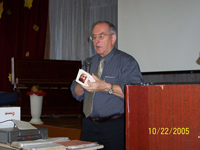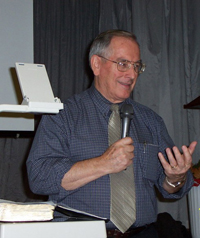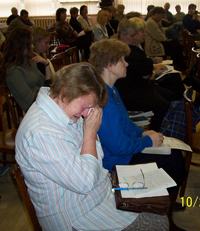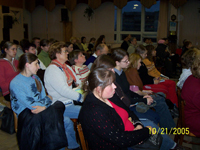 I am both a parent and child of Lutherans for Life (LFL). It was October 1978. I attended a meeting at Concordia College in St Paul, Minnesota. There, I met Dr. Jack Eichhorst (a friend from college days), Dr. Jean Garton, Pastor Dave Wende, Dr. Gene Linse, and two or three other participants. After discussing the state of the sanctity of life within Lutheran churches, a question was asked: “should we—could we—form an organization to promote the Sanctity of Life in Lutheran Churches of America?” The answer was “Yes.” By virtue of being concerned and being there, I and several of those present became board members of that new organization appropriately named Lutherans For Life. I served on the Board for about 20 years. Currently I serve as International Representative for Lutherans For Life.
I am both a parent and child of Lutherans for Life (LFL). It was October 1978. I attended a meeting at Concordia College in St Paul, Minnesota. There, I met Dr. Jack Eichhorst (a friend from college days), Dr. Jean Garton, Pastor Dave Wende, Dr. Gene Linse, and two or three other participants. After discussing the state of the sanctity of life within Lutheran churches, a question was asked: “should we—could we—form an organization to promote the Sanctity of Life in Lutheran Churches of America?” The answer was “Yes.” By virtue of being concerned and being there, I and several of those present became board members of that new organization appropriately named Lutherans For Life. I served on the Board for about 20 years. Currently I serve as International Representative for Lutherans For Life.
At the same time I am a child of LFL. Through many discussions at board meetings, conferences, and conventions, I learned much about the issues of life. I learned from Dr. Jean Garton’s incisive analysis of the issue summarized so clearly in her book, Who Broke the Baby? I learned from Dr. Jack Eichorst’s well-reasoned and clear defense of life as he synthesized the Bible, church fathers, the Lutheran Confessions, and modern medicine. I learned much from Dr. James Lamb’s insistence that the center of our mission is to proclaim the biblical message of life with the cross of Jesus Christ at its very center. I learned from Linda Bartlett how closely the sanctity of life message is related to femininity and chastity. Above all, I learned that the sanctity of human life is an inseparable and essential component of the biblical message.
To teach and preach the “whole counsel of God” (Acts 20:27 NKJV), especially in our age of genocide, one must include the sanctity of human life. To preach the gospel of forgiveness and healing through the cross of our Lord Jesus Christ, one must expose the sin of abortion so that sin can be brought to the foot of the cross, confessed and forgiven by the “blood of Jesus Christ His Son [who] cleanses us from all sin” (1 John 1:7). He alone can bring healing from that incessant and terrible accusation of law and conscience, “I killed my baby.”
After fourteen and a half years as pastor of Emmaus Lutheran Church in Minneapolis, Minnesota, the Lord called me to begin ministry in the former Soviet block countries. In the fall of 1992, I resigned as pastor and with a small group of co-workers we began the ministry of The East European Missions Network (EEMN) whose purpose is to encourage and help rebuild the churches in formerly Communist countries. I began making frequent trips to these countries. As I built relationships and trust with many pastors and lay members of those churches, it was a matter of being attentive to their concerns and waiting for the Lord to open the doors for the message of the Sanctity of Human Life.
 It was the fall of 1998. I had met pastor Sevolod Lytkin of Novo Sibirsk located in the south central area of the huge region of Siberia, Russia. He invited me to present a seminar on the sanctity of human life. I developed a simple approach that any of them could duplicate to teach the message.
It was the fall of 1998. I had met pastor Sevolod Lytkin of Novo Sibirsk located in the south central area of the huge region of Siberia, Russia. He invited me to present a seminar on the sanctity of human life. I developed a simple approach that any of them could duplicate to teach the message.
Teaching primarily from the Bible, I started with the Culture of Life showing how, because we are created in God’s image, [albeit an image marred by sin] our life is special and is to be honored and protected from the time of conception to natural death. Using the video Windows to the Womb, medical charts, and other medical information, I discussed the development of the baby. Secondly, again using the Bible, I explained the Culture of Death. When people turned away from God to idols, life became cheap. Despite the stern warnings of the prophets, murder of the innocent, child sacrifice, cruelty, and indifference to suffering became common. Then I would explain what abortion is, what the abortionist does, etc.
 There are almost always tears as people are made aware of the awful reality of what abortion really is and does. Knowing that most of the women in my audience had had abortions, and many of the men had forced women to do so, I was always careful to declare the message of the cross of Jesus Christ and His personal invitation to repentance and forgiveness. Almost always someone would come, confess, and accept forgiveness and new life through Jesus. One of those in Novo Sibirsk was Sayana, a lady from Tuim, a village of about 5000 people in the Republic of Khakassia near Mongolia. She had come 19 hours by train to attend that conference. Several times she asked to talk with me. Finally at the end we managed to find a quiet room and an interpreter. She confessed to having had three abortions. She was very eager to trust Jesus to forgive her. About two years later, she sent me a four-page poem she had written entitled The Eyes of Watching Children or The Silent Sin of the World. Here is an excerpt (translated from Russian).
There are almost always tears as people are made aware of the awful reality of what abortion really is and does. Knowing that most of the women in my audience had had abortions, and many of the men had forced women to do so, I was always careful to declare the message of the cross of Jesus Christ and His personal invitation to repentance and forgiveness. Almost always someone would come, confess, and accept forgiveness and new life through Jesus. One of those in Novo Sibirsk was Sayana, a lady from Tuim, a village of about 5000 people in the Republic of Khakassia near Mongolia. She had come 19 hours by train to attend that conference. Several times she asked to talk with me. Finally at the end we managed to find a quiet room and an interpreter. She confessed to having had three abortions. She was very eager to trust Jesus to forgive her. About two years later, she sent me a four-page poem she had written entitled The Eyes of Watching Children or The Silent Sin of the World. Here is an excerpt (translated from Russian).
Child, I created you in the womb
I enlightened you when I knew you
My eyes observed you
Until you were ready to enter the World
I called you child, My creation
And your days were appointed by Me
I entered your name in the book of life
Even when you hadn’t been born
But those days will not come to pass
The world has already dealt with your life
With hardened heart and cruel hand
The world murders unborn children
One moment—and the creation is destroyed
Your little heart is beating to the rhythm—and then the knife
Where to go? There is no escape, no protection
And you look with your life into their eyes
Thanks to the faithfulness of the pastors and people of the church in Novo Sibirsk, they now have a Crisis Pregnancy and Women’s Center.
We also taught the sanctity of life seminar in Abakan, the capital of Khakassia. Speaking to a group of social workers, psychologists, and even a representative of Planned Parenthood, I have seldom found such openness not only for information about abortion but for the message of the cross of Jesus Christ. I will never forget one of them remarking, “Why haven’t we heard of this before?” The message of the sanctity of life can truly be an evangelistic opportunity.
It was June 2002 in Petrozavodsk, northwestern Russia. As part of the annual Friendship English Language and Bible Camp, the director of the Language department of Lyceum #1, Professor Vera Smirnova, recognizing the damage abortion is causing in Russia, asked us to include some teaching about abortion, drugs, and sexuality in our curriculum.
As part of the teaching on abortion we used the video Windows to the Womb, which shows a baby in various stages of development kicking, jumping, sucking his thumb, etc. Nina, one of the Russian English teachers who was helping us, asked if she could borrow the video. Her unmarried daughter was pregnant and wanted to abort her baby. After we left, she showed the video to her. The next year Nina came to me while I was eating lunch. With a big smile she said “Could you come with me?” She led me to the hallway. There stood her daughter with a baby carriage. Wrapped in a soft, warm blanket was one of the most beautiful babies I had ever seen. Knowing how close this baby had been to death I could hardly keep from crying there in front of them.
Without God, human life inevitably becomes cheap and expendable. In the former Soviet Union, where “scientific atheism” was the law of the land, abortion was a completely accepted part of their way of life—or, more accurately, death. The average woman has had at least eight abortions. (That statistic varies from 4 to 14.) A friend in Latvia told me his mother had 11 abortions.
The womb is indeed the most dangerous place for the child. Abortion has become so deeply and tragically entrenched in the culture that even the medical community considers it a duty to encourage it. When a pregnant woman goes to the doctor often his first act is to try to schedule an abortion for her. He will say something like this: “When would you like me to schedule you for ‘the break?’” Others call it “the interruption” or “the cleansing.” He is referring to the break from having to bare and care for a child. When the lady across the hall or her friend finds out she is pregnant, frequently her first question might be “when are you going to have it taken care of?” If the mother is going to keep her baby because that living baby becomes a testimony to her own sin and guilt, the indignant reaction might be “what right do you think you have to have your baby, do you think you’re better than we are?”
During the fall of 2002, I was visiting EEMN missionaries Pastor Martin and Gunta Irbes in northern Latvia. The Latvian Parliament had just passed a law legalizing abortion. Because the Christians in Latvia were upset by this law, there was much discussion among them. Some had introduced a petition which, because it was so poorly crafted, most knowledgeable Christians couldn’t sign. I was eventually interviewed by a local television station. Because they forgot to turn on the sound, the interview could not be broadcast. As a result Gunta Irbes asked if we could do a seminar in Riga. I agreed. She made a few phone calls. The next night there were 50 to 60 people in the auditorium of the “consistitory” or main church offices. That prompted us to plan a national conference for the next year. Subsidized by Lutherans For Life (USA), this conference was held in St. Matthews Baptist church in Riga as it was the only one with enough space for the conference. All of the main churches were represented. Archbishop Janis Vanags of the Latvian Lutheran Church was the first speaker followed by bishops of all the main churches. He and his staff have been very supportive of this effort. This was the first such conference in Latvia. It received much press and media coverage while broadly expanding the sanctity of life message in Latvia. Thanks to the ongoing work of Pastor Martins and Gunta Irbes, every year since, there has been a sanctity of life conference.
As part of the conferences, I have always been asked to write an article for the church paper and a sample sermon which is sent to all the pastors. As a result of his sermon, one pastor received a call from a member of his congregation who had been planning an abortion but because of his message decided to keep the baby.
We have presented the Sanctity of Life message in several schools. Many women have found forgiveness of the sin of abortion as a result of these conferences.
I am usually asked to preach a Sanctity of Life message in the Riga Dom, the cathedral of the Latvian Lutheran Church. In an attempt to honor pregnant mothers and their husbands, if there is a couple attending the service, I will ask them to come forward and pray for them and their unborn baby. We also present the biblical teaching on sexuality. The little brochure Made For One (one God, one Savior, one spouse and sexual relationships only with that spouse) has been very helpful in presenting that message. A crisis pregnancy center has opened in Latvia. In part because of the exposure given to the issue of abortion through the conferences, there were more than enough volunteers to staff the center.
It was May 2003 when Pastor Bill Moberly, the new director of EEMN, and I were visiting at the seminary of the Ingrian Lutheran Church. Just before we were about to leave we met missionary Leif Camp, a pastor of the Lutheran Church-Missouri Synod. Within minutes we discovered a mutual concern for the unborn child. Because his Russian-born wife had gone through the indignities of their medical system, they were very concerned about this issue. For example, it appears to be quite common that a woman who has just given birth to her child can be in the same room with another woman who has just had her baby aborted. Besides the very inadequate sanitary conditions, we frequently hear how women are treated almost like animals.
Though one would be tempted to ask what she think happens to her baby, the treatment given Olga Lipovskaya, 35 years old, married three times, and with two children, and seven abortions, illustrates this callous treatment: “You stand in line before the door of the operating room, seven or eight of you, waiting to be taken in. The clinic’s staff is too busy to do anything but operate, so as each woman who’s finished staggers out you take turns getting out of line for a few minutes, just to help her get to the resting room down the hall. Then it’s your turn, and you go into a hall splattered with blood where two doctors are aborting seven or eight women at the same time. They’re usually very rough and rude, shouting at you about keeping your legs wide open . . . if you are lucky they give you a little sedative, mostly Valium. Then it’s your turn to stagger out to the resting room, where you’re not allowed to spend more than two hours because the production line, you see, is always very busy.” Olga estimates she will have had about 14 abortions in total, which she guesses to be the national average. (See the University of Utah’s Journal of Undergraduate Research, 1996, pp. 11-24.)
We have now had two sanctity of life conferences in St. Petersburg, Russia, and one in Petrozavodsk. Also, thanks to the enthusiastic leadership given by Pastor Leif and Genia Camp, they have had conferences in other cities. Bishop Arre Kougappi of the Ingrian Lutheran Church has always opened the conferences with a strong biblical pro-life message and is encouraging the pastors and people of his church to share the message of Life. In the last year, they have opened Hope (Nadezda) a family counseling and crisis pregnancy center in the church headquarters building in the heart of St. Petersburg. Oleg Rymmin, the director of the center is opening a counseling office in Maternity Clinic # 6 in St. Petersburg. Pastor Leif Camp and his wife Genia along with several Russian pastors are giving leadership to this new Lutherans For Life ministry in Russia.
 In October of 2005, I was attending a conference celebrating the 100th anniversary of the Christian Fellowship, an organization of lay people dedicated to evangelism, church growth, and renewal. They were especially important during the Communist years when pastors were carefully controlled by the secret police. Sitting across the table from Renata Hinrichs, wife of EEMN missionary Tim Hinrichs, and Pauline, the president of the Polish Lutheran Church women, we discussed the issue of the sanctity of life. She asked if we could help them with a pro-life conference. We began making plans. Soon the Center of Mission and Evangelism who, among other things, sponsors a widely-heard radio ministry, indicated they wanted to participate. In April 2006, we held the first such conference in the Polish Lutheran Church. We met with about 25 pastors, with youth, and with a general audience. I am grateful to Mike and Mary Means, pro-lifers from Oklahoma, who came to help. I am also deeply grateful to God for the Polish participants who spoke. They displayed remarkable insight into the issue.
In October of 2005, I was attending a conference celebrating the 100th anniversary of the Christian Fellowship, an organization of lay people dedicated to evangelism, church growth, and renewal. They were especially important during the Communist years when pastors were carefully controlled by the secret police. Sitting across the table from Renata Hinrichs, wife of EEMN missionary Tim Hinrichs, and Pauline, the president of the Polish Lutheran Church women, we discussed the issue of the sanctity of life. She asked if we could help them with a pro-life conference. We began making plans. Soon the Center of Mission and Evangelism who, among other things, sponsors a widely-heard radio ministry, indicated they wanted to participate. In April 2006, we held the first such conference in the Polish Lutheran Church. We met with about 25 pastors, with youth, and with a general audience. I am grateful to Mike and Mary Means, pro-lifers from Oklahoma, who came to help. I am also deeply grateful to God for the Polish participants who spoke. They displayed remarkable insight into the issue.
It is assumed that because of the convictions of the Roman Catholic Church there are few abortions in Poland. One of the speakers, a young female seminary professor, indicated there is in fact a high incidence of abortion in Poland. Many of them are called “tourist abortions” as they can go across the border to the Czech Republic, Slovakia, Ukraine, or Bela Rus and obtain one very easily. Remarking that this was the first time they had ever had a public discussion of this issue, the people were very receptive and grateful to learn that Lutherans have an opinion about this issue and that it is not “just a Catholic issue.”
July 24, 2006, I completed a seminar for youth in Poland on the Sanctity of Life. One of the participants, a university student from the Ukraine, was in tears as she shared the news that her cousin, with whom she was very close, was going to have an abortion the next day. After we talked and prayed, she sent an e-mail to her cousin, pleading with her not to make the terrible mistake of killing her own child. Of the 25-30 students present in that seminar only two indicated they had received any teaching on this issue.
I have also been asked to share the biblical message of the sanctity of human life at conferences in Slovakia. Again, the participants were very receptive to the message of life and healing through the cross of our Lord Jesus Christ.
Because of the enormity of the damage the culture of abortion has done to the people in Eastern Europe and the former Soviet Union, as a matter of course when I am counseling, I almost always ask if they have had an abortion or induced someone else to have one. I recall no incidence when people were offended by this question. To the contrary, if they have had an abortion, they are relieved that they can talk about it, confess it, and find new beginnings through the cross of our Lord Jesus Christ.
In conclusion, I thank the Lord of Life for the privilege of sharing His word of grace and hope, and the Lutherans For Life family in the U.S. who support and pray for this ministry. I am grateful to the faithful people of God in those formerly Communist countries where it was dangerous to confess Jesus as Savior and Lord who now want to learn how His Word can produce among them a culture of life.
May the emerging Signs of Life become a monumental wave of love for human life from conception to natural death.